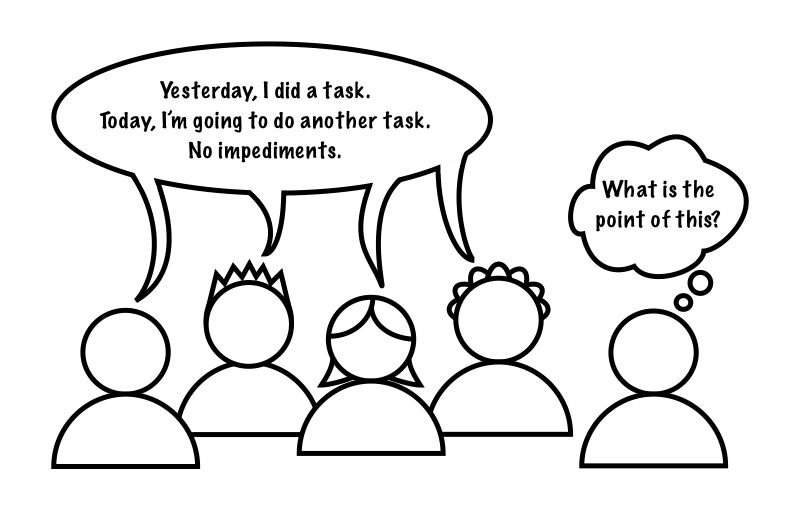How to achieve Daily Standup greatness? Let’s start with how not to! “Yesterday I …, today I …, no impediments.”

These are the infamous 3 questions associated with the Daily Standup (also called Daily Scrum). Using this format for your Daily Standups is a guaranteed way to ensure this event sounds like a verbal status report, is boring, and is considered wasteful by the team members.
Someone please wake me up! For a hilarious video, check it out here.
Anti-Patterns
Any approach for the Daily Standup that calls on each individual should now be considered an anti-pattern. For example:
- “Yesterday I …, today I …, my impediments are …”
- Scrum Master (or anyone) calling on team members to speak
- Team members giving a verbal status report to the Scrum Master
- Jira board facilitator filtering on individual team member names
- No pairing or swarming of work items
If your Daily Standup sounds or feels like any of the above, then please do something about it!
Scrum Master Advice for Daily Standup Greatness
Scrum Masters need to understand that the 3 questions are no longer listed in the latest official Scrum Guide (November 2020). Originally shown as the technique, then relegated to an example, and now fully jettisoned. I’m sure there was a good reason it was pulled – it sounds like a status report, and it emphasizes individuals over the team.
Also, you may not understand that the Daily Scrum is an event for the Developers to synchronize their plan for today. Why not ask the Developers to come up with their preferred way to perform the event?
SAFe Issue
Unfortunately, SAFe 5.1 still lists these 3 Questions in their Iteration Execution article. The questions are also included in the SAFe training.
SAFe’s position is that teams new to Agile will benefit from this type of individual report. I disagree wholeheartedly. Why introduce a team – regardless of experience – to an immature approach that will make this important event sound like a status report? Are we saying a new team just can’t handle the better approach (see below)?
Hopefully new versions of SAFe will adjust or remove this poor guidance.
A Better Way to Daily Standup Greatness!
Try this instead:
- Review the Iteration Goal
- Kanban teams: review any short-terms goals
- Walk the board from right to left – discussing the work items closest to Done
- This keeps the focus on the work and what we can do as a Team to complete something today!
- Encourage pairing and swarming by asking questions such as:
- “Who can pitch in to work this item and get it to Done today or tomorrow?”
- “Who can work with them to get it Done sooner?”
- “Does this work item present a learning opportunity for someone else?”
- Ensure all impediments have agreed-upon action items with names assigned
- Near the 15-minute mark, end the event with questions such as:
- “Is anyone working on items not shown on our board?”
- “Do we feel like we have a good plan of attack for today for achieving the Iteration Goal?”
- “Do we feel synchronized as a team?”
Notice how the Iteration Goal is bookended in the recommended new format.
Wrap – Daily Standup Greatness
For how to choose a SAFe training partner, check it out here.
The Daily Standup’s purpose is to create a synchronized plan for today. This plan should maximize the team’s effectiveness in achieving the Iteration Goal.
Verbal status reports don’t cut it. Stop the madness. We can do better!
